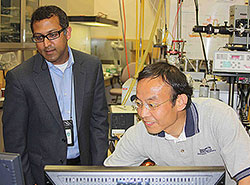Catalyst Developer's 9-Week Fellowship at National Lab is a Win-Win
Johnson Matthey's Hai-Ying Chen takes opportunity to work at PNNL's IIC

Johnson Matthey catalyst developer Hai-Ying Chen shows results from a spectroscopy study of the SCR reaction mechanism to Reuben Sarkar, Deputy Assistant Secretary for Transportation, DOE Office of Energy Efficiency and Renewable Energy, during Sarkar's visit to PNNL July 15. Chen was a visiting scientist at PNNL during the summer of 2014.
Hai-Ying Chen is a scientific and product development manager at Johnson Matthey, a world leader in catalyst technology. At the company's Emission Control Technologies Division in Wayne, Pennsylvania, he is responsible for developing advanced emission control catalysts that enable automotive vehicles to meet government emission regulations.
But this summer, instead of his typical work schedule, interspersed with family vacations and activities, Hai-Ying went west–across the country to Richland, Washington, to work as a visiting scientist in the Institute for Integrated Catalysis (IIC) at Pacific Northwest National Laboratory (PNNL).
This wasn't his first time at PNNL, although his position as an "alternate sponsored fellow" was a first between Johnson Matthey and the national lab. In 2003, Johnson Matthey, diesel engine manufacturer Cummins Inc., and PNNL began a project on NOx emission control using NOx storage and reduction (NSR) catalysts–also known as lean-NOx traps or NOx absorber materials. The goal was to understand the modes of deactivation thereby providing ways to improve the catalysts' stability and performance.
This project was done through a cooperative research and development agreement (CRADA), which is a contractual agreement between a federal lab and one or more partners from businesses or universities. All of the partners agree to collaborate, share costs, and pool the results of the project.
According to Chuck Peden, associate director of the IIC, "In the CRADA, Johnson Matthey was willing to trust us with some sensitive proprietary information. This was absolutely crucial to our ability to perform practical relevant research on the NSR catalyst's stability. We hope we've continued to justify their trust while at the same time identifying important publishable results to aid the R&D community from our Department of Energy (DOE) -funded work."
The first phase of the CRADA was highly successful. The joint effort facilitated implementation of the NSR technology on vehicles, meeting U.S. Environmental Protection Agency 2010 emission regulations 3 years ahead of time. The CRADA was renewed in 2010, and in the second phase, the research focus shifted from the NSR technology to Selective Catalytic Reduction systems, or SCR technology.
Figuring out a fellowship
Hai-Ying and Chuck began discussing the possibility of setting up the alternate sponsored fellow position in late 2013 because of their common interest in understanding the formation mechanisms of one of the undesirable products from the SCR process, the greenhouse gas nitrous oxide (N2O). In particular, recent research at Johnson Matthey and PNNL had shown that some catalysts produced much more of this environmentally harmful gas than others, for reasons as yet unknown. And Hai-Ying had additional motivation.
"The combination of scientific expertise and state-of-the-art instrumentation at EMSL was extremely appealing," he said. "Chuck Peden and his group are among the leaders in this particular field, with an excellent publication record." EMSL is a Department of Energy Office of Science User Facility located at PNNL, sponsored by the Office of Biological and Environmental Research.
What Hai-Ying doesn't mention is his own excellent reputation, having won an ACS Award for Team Innovation in 2009, the Chicago Catalysis Club's 2014 Herman Pines Award for advancement of environment catalysis and technology, and the 2014 Catalysis Club of Philadelphia Award. He also has 15 patents and more than 50 publications.
Both Johnson Matthey and PNNL management were extremely supportive of the idea, and his term at the lab began on June 30 and ended August 29.
"This is a great example of how PNNL and industry are working together bringing fundamental, DOE-funded scientific tools and capabilities to the table to solve the challenging issues that face clean energy," said Jud Virden, Associate Laboratory Director for Energy and Environment at PNNL.
Hai-Ying added, "It's a major step for a private industrial company to closely collaborate with a national lab in such a competitive field, where proprietary information is the norm. I am very lucky to have the opportunity to carry out the study at PNNL."
During his 9-week assignment at the IIC, Hai-Ying used Fourier transform infrared (FTIR) spectroscopy to study SCR model catalysts that resemble the commercial copper-exchanged small-pore zeolite catalysts. The goal is to understand why the current commercial catalysts produces less N2O than the previous generation of copper-exchanged medium- or large-pore zeolite catalysts, and use this understanding to improve future materials.
The results of his work have been gratifying.
"We have achieved more than we originally anticipated by identifying characteristics in the FTIR data that clearly distinguish the new small-pore zeolite catalysts from the prior generation materials. These new results will directly allow us to propose a rationale for the observed differences in N2O formation. We would like to continue this working relationship, and the N2O selectivity project, as well," said Hai-Ying.

